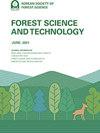Allometric equations for the estimation of above- and below-ground biomass for Larix sibirica Ledeb. in Northern Mongolia
IF 2.2
Q2 FORESTRY
引用次数: 2
Abstract
Abstract The accurate estimation of tree above-ground (AGB) and below-ground (BGB) biomass components and their root/shoot ratio play key roles in stand and country-level forest biomass and carbon stock estimation. Nevertheless, site-specific and appropriate biomass equations and root/shoot ratio are hardly available for natural larch (Larix sibirica Ledeb.) forests in Mongolia. The present study aimed (1) to develop allometric equations to estimate the above- and below-ground biomass of L. sibirica trees, and (2) to estimate the root/shoot ratio applicable for estimating the root biomass based on above-ground biomass of natural larch forests in northern Mongolia. A total of 40 trees with DBH ranging from 6.8 to 40.8 cm were sampled for tree biomass analyses. For each biomass component, we calculated the proportion of biomass allocated to different components, and also tested four allometric equations based on diameter at breast height (DBH) and height (H) as independent variables. Our results, based on measurements of oven-dried biomass, revealed that stem biomass on average accounted for 44.5% and followed by branch (28.6%) and root (19.9%) biomass, respectively. Stem and branch biomass proportions were gradually increased with increasing DBH, while a contrary trend was observed for needles. The root/shoot ratio averaged 0.25. A comparison of the allocation of root biomass by diameter fractions showed an ever-growing trend of coarse roots with an increase in stem diameter, which often exceeded more than 50% of the total root biomass. However, biomass equations, which include both DBH and H were more precise than equations that are solely based only on DBH. Consequently, among the proposed allometric regression models for estimating the AGB and BGB, the equation y = aD b H c was selected as the best-fitted equation for estimating each biomass component in Siberian larch forests. These allometric equations are available to be used for the estimation of natural larch forest biomass and carbon stocks in the Khentii Mountains of Mongolia, where extreme continental climate conditions dominate.西伯利亚落叶松地上、地下生物量估算的异速生长方程。在蒙古北部
准确估算树木地上(AGB)和地下(BGB)生物量组成及其根冠比在林分和国家级森林生物量和碳储量估算中起着关键作用。然而,蒙古天然落叶松(Larix sibirica Ledeb.)林的立地特异性和适宜的生物量方程和根冠比很难得到。本研究的目的是:(1)建立西伯利亚落叶松地上和地下生物量的异速生长方程;(2)以蒙古北部天然落叶松地上生物量为基础,估算适用于根系生物量估算的根冠比。选取胸径6.8 ~ 40.8 cm的40棵乔木进行生物量分析。对于每个生物量组分,我们计算了分配给不同组分的生物量比例,并测试了以胸径(DBH)和高度(H)为自变量的4个异速生长方程。研究结果显示,干生物量平均占44.5%,其次是树枝(28.6%)和根系(19.9%)。茎、枝生物量比例随胸径的增加而逐渐增加,而针叶生物量比例则相反。根冠比平均为0.25。根系生物量按径级分配的比较表明,粗根随着茎粗的增加呈不断增长的趋势,粗根占总根系生物量的比例往往超过50%以上。然而,包括胸径和胸径的生物量方程比仅基于胸径的方程更精确。因此,在估算西伯利亚落叶松林分生物量和生物量的异速生长回归模型中,y = aD b H c是估算西伯利亚落叶松林分生物量各组分的最佳拟合方程。这些异速生长方程可用于估计蒙古Khentii山脉的天然落叶松森林生物量和碳储量,那里的极端大陆性气候条件占主导地位。
本文章由计算机程序翻译,如有差异,请以英文原文为准。
求助全文
约1分钟内获得全文
求助全文

 求助内容:
求助内容: 应助结果提醒方式:
应助结果提醒方式:


